LONSDALE WALL
|
| Type of dive: |
|
Reef |
| Snorkelling: |
|
No, too deep (Accessible for free divers) |
| Scuba: |
|
Open Water (Advanced recommended) |
| Access: |
|
Boat only (20-30 minutes) |
| Depth: |
|
8 – 40+ metres (25-130+’) |
| Visibility: |
|
5 – 25 metres (15-80’) |
| Water temperature: |
|
11 – 22°C (52-72°F) |
| Seasonal: |
|
No, but November to June best |
The remnants of the old Yarra River now form spectacular underwater walls in southern Port Phillip Bay.
Port Phillip Bay’s entrance, colloquially known as in the ‘Heads’ or the ‘Rip’, is one of the world’s most dangerous navigable waters and has been responsible for numerous ship wrecks and many other nautical tragedies.
Melbourne’s Port Phillip Bay formed around 8,000-6,000 BCE and its narrow entrance was the mouth of the Yarra River as it entered Bass Strait. Today the river mouth is further north in Melbourne at Williamstown.
The first of these spectacular walls is Portsea Hole, just off Portsea to the north east of the Heads, where the wall ranges in depth from 14 to 27 metres (45-90’). Portsea Hole is a special marine park and boasts an amazing array of fish life, it has been a favourite of Melbourne divers for over 40 years.
Spectacular Reef, the name says it all, is located roughly half way between Portsea Hole and the Heads and its vertical wall ranges from 18 to 40 metres (60-130’).
In the entrance itself, there is a huge canyon reaching 90 metres (300’) in depth.
The south side of the canyon is called Nepean Wall and Lonsdale Wall, the Wall, is to the west. Both are marine Parks.
The Wall starts to the north at Boarfish Reef and ends in the south west at Fog Reef and runs for some three kilometres (2 mi). It hosts dozens of spectacular dive sites.
The top of Lonsdale Wall starts in eight metres (25’) and within a short distance, rapidly drops to depths in excess of 40 metres (130’).
As the wall gets deeper, there are terraces with huge undercuts and overhangs that support an enormous array of invertebrate life including corals, sea spiders, nudibranchs, sponges and ascidians.
Long-snout boarfish are common on the top of the Wall and spectacular blue devil fish are prevalent in the ledges at around 18 metres (60’). Large schools of barber perch are usually present just off the Wall toward the deeper water.
Divers need to be careful, whilst the next terrace down may appear not so far, before you know it, you will be unintentionally in very deep water!
Because of the strong currents caused by tidal flow, dive times for Port Phillip Heads dive sites are usually limited to a 20 to 30-minute window of slack water.
The tides in the area are semidiurnal, that is, there is a high and low water roughly every 12.5 hours and hence a short slack water period every 6.25 hours.
Slack water normally occurs at the top or bottom of the tidal cycle, however, in the Heads it occurs half way between low and high tides due to the narrow entrance delaying the flow of water into and out of Port Phillip Bay.
Although Tidal Predictions are published every year, published slack water times can vary significantly due to weather conditions such as wind strength and direction, and atmospheric temperature.
Slack can be early or late, and sometimes by a long time.
Due to the unpredictability of slack water, dive boat operators generally plan to arrive on-site early to avoid a rush should the tide be early. Unfortunately, if ‘slack’ is late then divers must exercise some patience.
Lonsdale Wall and the other great Port Phillip Heads dives can be accessed from either Queenscliff or Portsea via a short boat ride.
Copyright © 2024 Steve Sinclair
Other great dive sites to visit while you are there:
Popes Eye, Boarfish Reef, Fog Reef, Portsea Hole, 90ft (27m) Sub (J4), Winged Sub (J1), SS Coogee, Ex-HMAS Canberra and Eliza Ramsden.
Local dive services:
|
|
SCUBABO DIVE VICTORIA |
 |
BLAST EXPERIENCES |
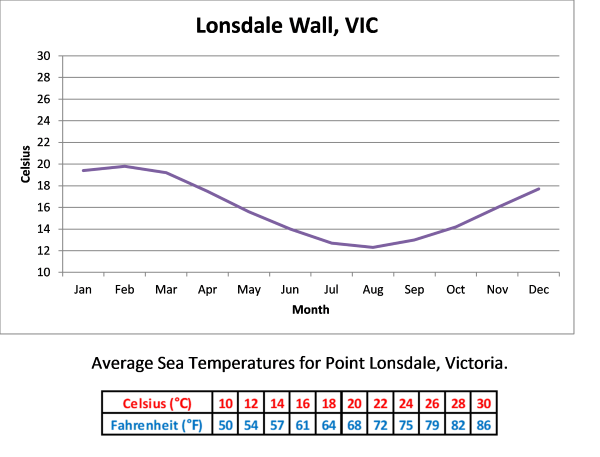
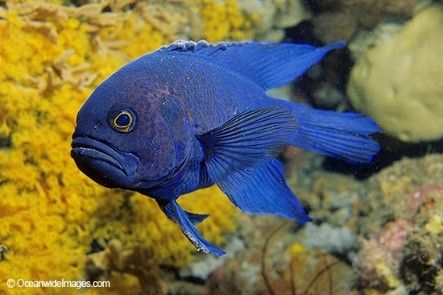
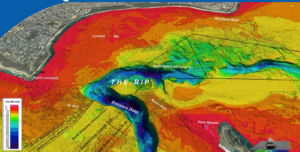


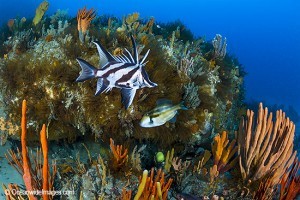
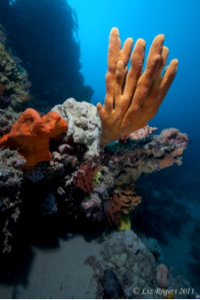
OTHER INFORMATION
LOCATION
State or Territory:
Victoria
Nearest City:
Melbourne
Nearest Regional City:
Not relevant
Nearest Town:
Queenscliff/ Portsea
HOW TO GET THERE
Air:
Nearest International Airport:
Melbourne
Nearest Domestic/Regional Airport:
Avalon for Queenscliff/Melbourne for Portsea
Road:
Melbourne to Queenscliff:
1.5 hours (110 km/70 mi) via M 1
Melbourne to Portsea:
1.5 hours (110 km/70 mi) via M 1 and Mornington Peninsula Fwy/M11
Bus:
From Melbourne
Train:
Queenscliff:
From Melbourne to Geelong then bus
Portsea:
Not available
Ferry:
From/to Sorrento or Queenscliff
THINGS TO DO
Queenscliff:
Bay Eco Tour
Fishing
Marine Discovery Centre
Blues Train
Queenscliff Fort
Bellarine Railway
Maritime Museum
Wineries
Portsea:
Sea Kayaking
Fishing
Surfing
Wineries
Point Nepean Quarantine Station
Point Nepean National Park
Fort Nepean



















